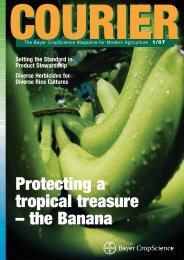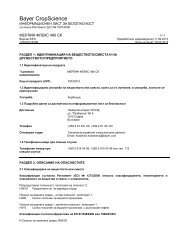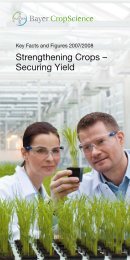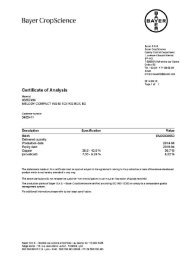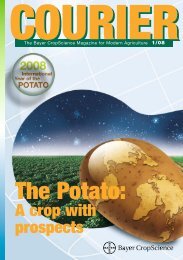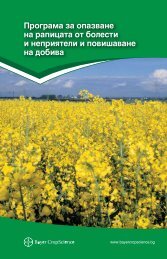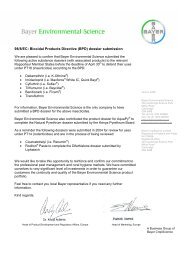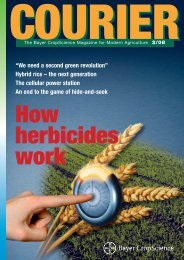For healthy potatoes - Bayer CropScience
For healthy potatoes - Bayer CropScience
For healthy potatoes - Bayer CropScience
Create successful ePaper yourself
Turn your PDF publications into a flip-book with our unique Google optimized e-Paper software.
Hugely successful in corn, the use of<br />
hybridization by plant breeders to improve<br />
crop productivity is now prevalent in a vast<br />
array of cereal, horticultural and vegetable<br />
crops. <strong>Bayer</strong> <strong>CropScience</strong> has developed<br />
an expertise in the production of quality<br />
hybrid seed in canola and, to a smaller<br />
extent, cotton and in the most recent crop<br />
embracing hybrid vigor, rice.<br />
Breeding and plant pollination<br />
A hybrid is the result of a cross between<br />
two genetically distinct parent lines. When<br />
the right parents are selected, a hybrid will<br />
have both greater vigor and yield than<br />
either of the parents. Hybrids also tend to<br />
have increased resistance to diseases and<br />
insects.<br />
The process of breeding hybrids,<br />
“hybridization”, is achieved through the<br />
use of what is called a pollination control<br />
system that renders the pollen of one parent<br />
line non-viable (male sterile or female<br />
line) to ensure pollination by the chosen<br />
parent line. One of the most common<br />
methods to eliminate self-pollination is<br />
emasculation through the mechanical<br />
removal of the anthers.<br />
In corn, where the male flowers are separated<br />
from the female flowers, the process<br />
is called “detasseling” and involves the<br />
removal of the male flowers from the plant.<br />
Genetic methods can also be used to generate<br />
the desired male sterility in hybrid<br />
seed production, particularly in crops that<br />
possess full or “perfect” flowers (male and<br />
female) and that “have a moderate degree<br />
of out-crossing, produce few seeds per<br />
flower, and for which the costs of manual<br />
castration techniques cannot be recovered<br />
by the price of the seed.” 2<br />
Why Farmers use F1 Hybrids<br />
There are three very good reasons why<br />
farmers are interested in first generation<br />
filial (F1) hybrids. The first is to obtain<br />
higher yields through a phenomenon<br />
known as hybrid vigor (heterosis) or heterozygote<br />
advantage. The second is uniformity.<br />
Every plant in an F1 is identical (with<br />
some genetic variation in the inbreds that<br />
gets multiplied when the inbreds are<br />
crossed) and this uniformity can be advantageous<br />
when you are trying to harvest a<br />
field at one time, by a machine. The third<br />
is the availability of certain hybrid gene<br />
combinations that are only present in a<br />
commercial F1 and that are technically<br />
impossible in an inbred line.<br />
If farmers plant the seeds of a hybrid<br />
crop (F2, F3…), then the resulting crop<br />
will deliver disappointing results. The<br />
growth will not be uniform, harvests will<br />
show mixed grain types and will have lost<br />
its yield advantage. <strong>For</strong> this reason, a fresh<br />
batch of F1 hybrid seed should be planted<br />
for every crop. Indeed, from a farmer’s perspective,<br />
hybrids are best used when the<br />
increased yields from hybrid vigor will<br />
more than pay for the extra cost of planting<br />
seed; the added premium being uniformity. 3<br />
Producing Commercial F1 Seed<br />
The production of commercial hybrid seed<br />
for sale to farmers is an expertise intensive<br />
– as opposed to capital intensive – exercise.<br />
It requires considerable agronomic and<br />
genetic expertise to produce quality seed in<br />
general and hybrid seed in particular.<br />
Within <strong>Bayer</strong> <strong>CropScience</strong>, the process<br />
begins with our expert breeders developing<br />
and then selecting the most desirable parent<br />
lines to form a high quality male and<br />
female gene pool. Once selected, these<br />
lines are handed over to our expert ‘Parent<br />
Seed Team’ to be grown and multiplied.<br />
The parent lines are then coded and dispatched<br />
to contracted farmers who will<br />
grow the seed under the supervision of our<br />
Certified F1 Seed Production Team. The<br />
team is comprised of expert breeding and<br />
production agronomists who ensure the<br />
quality and grade of the seed throughout<br />
the product cycle. The parent lines are kept<br />
separate in the field and are often sown at<br />
different times to ensure the synchronized<br />
development (flowering) of the male and<br />
female lines and to maximize cross-pollination.<br />
The team works with the contracted<br />
farmers who are paid a premium for growing<br />
the coded parent lines in accordance<br />
with the specified protocol. The harvested<br />
seed is then sent back from the farms to<br />
<strong>Bayer</strong> <strong>CropScience</strong> for quality evaluation<br />
and grading and is cleaned, treated, coated,<br />
bagged and distributed.<br />
1+2) Introduction to Plant Breeding –<br />
Briggs & Knowles 1967<br />
3) Ibid<br />
2/06 COURIER 17





